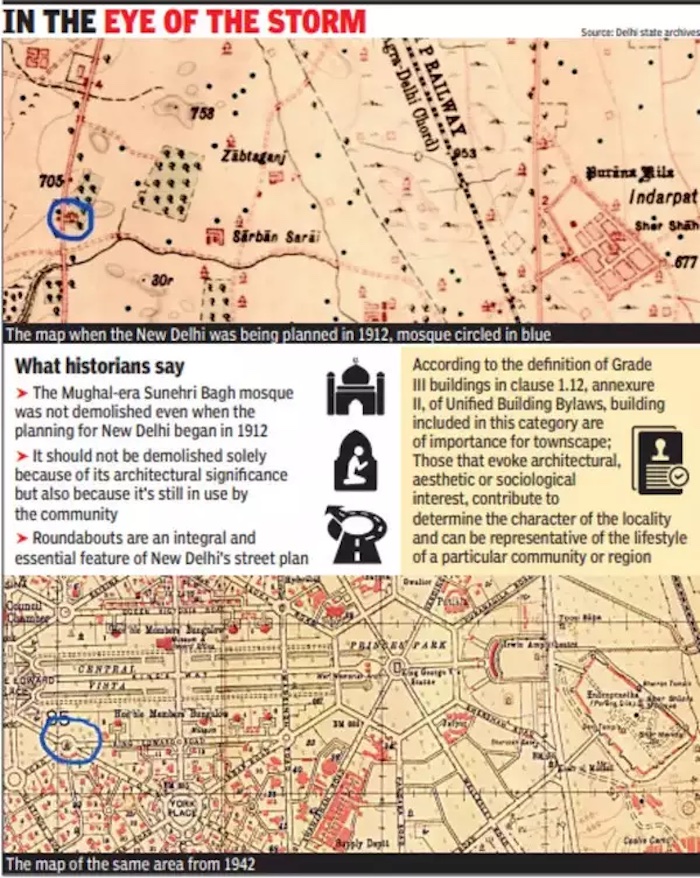Delhi: Sunehri Bagh mosque
(Created page with "{| class="wikitable" |- |colspan="0"|<div style="font-size:100%"> This is a collection of articles archived for the excellence of their content.<br/> Additional information ma...") |
|||
| Line 7: | Line 7: | ||
|} | |} | ||
| − | + | ||
| − | + | ||
| − | + | ||
=A backgrounder= | =A backgrounder= | ||
| Line 15: | Line 15: | ||
[https://timesofindia.indiatimes.com/city/delhi/lutyens-left-mosque-untouched-find-other-solutions-historians/articleshow/106366201.cms Anuja Jaiswal, Dec 29, 2023: ''The Times of India''] | [https://timesofindia.indiatimes.com/city/delhi/lutyens-left-mosque-untouched-find-other-solutions-historians/articleshow/106366201.cms Anuja Jaiswal, Dec 29, 2023: ''The Times of India''] | ||
| − | [[File: Delhi | + | [[File: Delhi- Sunehri Bagh mosque.jpg|Delhi: Sunehri Bagh mosque <br/> From: [https://timesofindia.indiatimes.com/city/delhi/lutyens-left-mosque-untouched-find-other-solutions-historians/articleshow/106366201.cms Anuja Jaiswal, Dec 29, 2023: ''The Times of India'']|frame|500px]] |
''' Lutyens Left Mosque Untouched, Find Other Solutions: Historians ''' | ''' Lutyens Left Mosque Untouched, Find Other Solutions: Historians ''' | ||
| Line 34: | Line 34: | ||
“Lutyens was sensitive enough to modify his street plans to showcase monuments like Safdarjung's madrasa and Humayun's Tomb’s garden. He cleverly incorporated this little masjid into one of his roundabouts. Instead of learning from him, our present town controllers pay homage only to VIP cars,” said historian Narayani Gupta.
|
“Lutyens was sensitive enough to modify his street plans to showcase monuments like Safdarjung's madrasa and Humayun's Tomb’s garden. He cleverly incorporated this little masjid into one of his roundabouts. Instead of learning from him, our present town controllers pay homage only to VIP cars,” said historian Narayani Gupta.
| ||
| + | |||
| + | [[Category:India|D | ||
| + | DELHI: SUNEHRI BAGH MOSQUE]] | ||
| + | [[Category:Pages with broken file links|DELHI: SUNEHRI BAGH MOSQUE]] | ||
| + | [[Category:Places|D | ||
| + | DELHI: SUNEHRI BAGH MOSQUE]] | ||
| + | [[Category:Religion|D | ||
| + | DELHI: SUNEHRI BAGH MOSQUE]] | ||
Revision as of 10:56, 24 January 2024
This is a collection of articles archived for the excellence of their content. |
A backgrounder
As in 2023
Anuja Jaiswal, Dec 29, 2023: The Times of India

From: Anuja Jaiswal, Dec 29, 2023: The Times of India
Lutyens Left Mosque Untouched, Find Other Solutions: Historians
Swapna Liddle Points Out How Sunehri Bagh Mosque Placed On Roundabout
New Delhi : Noted historian Swapna Liddle has pointed that the mosque survived the ravages of time and major colonial reconstruction of the city in 1912. Sharing two maps (1912 and 1942), Liddle said that when New Delhi was planned in 1912, a map was dawn up which showed some of the old buildings, including the mosque set in a garden (circled in blue), located beside what was then called Qutub Road. The garden was called ‘Hakim ji ka bagh’ and also 'Sunehri Bagh’.
She said the map was meant to help the city planners decide which of these buildings should be demolished to make way for the new city and which were to be saved. “Many, including tombs and palaces, were in fact demolished but some remained, among which was this Mughal period mosque. The reason was that it was not only of architectural significance but it was also in use. So, it was decided to incorporate it in the town plan by placing it on one of the many roundabouts in the new city. The map of the same area dating to 1942 shows this,” she said.
Liddle said that in late 1990s, the Delhi chapter of Indian National Trust for Art and Cultural Heritage (INTACH) listed the mosque as a heritage building worthy of being preserved and went on to file a PIL to ensure that such buildings were given legal protection. This was achieved in 2009 when this mosque was notified as a Grade III heritage building.
There are two aspects of this mosque — one is history and heritage and the second is its emotional connect with the minority community whose members still offer prayers here, said historian Rana Safvi.
She said the almost 200-yearold mosque is still being used by people. Around 500 people offer prayers here every Friday. “Where will the community members who offer prayers here every day go to pray,” she asked, adding that everyone knows that offering prayers on the road is a problem. “There are so many other ways in which the traffic problem around the mosque can be resolved,” she said, underlining the fact that the mosque is not standing in the middle of the road – it’s a roundabout.
Liddle, in fact, said that its location on the roundabout is evocative of the town plan of New Delhi, which sought to incorporate many historic structures, particularly those in active use, as features of the new city plan instead of demolishing them.
“Lutyens was sensitive enough to modify his street plans to showcase monuments like Safdarjung's madrasa and Humayun's Tomb’s garden. He cleverly incorporated this little masjid into one of his roundabouts. Instead of learning from him, our present town controllers pay homage only to VIP cars,” said historian Narayani Gupta.